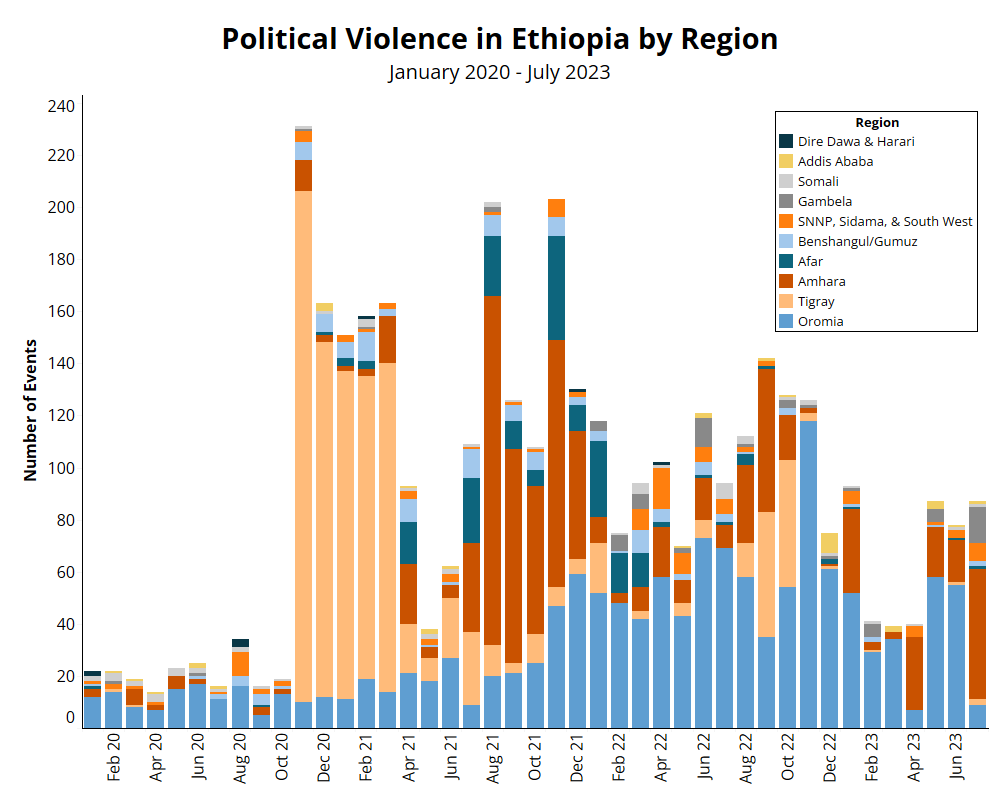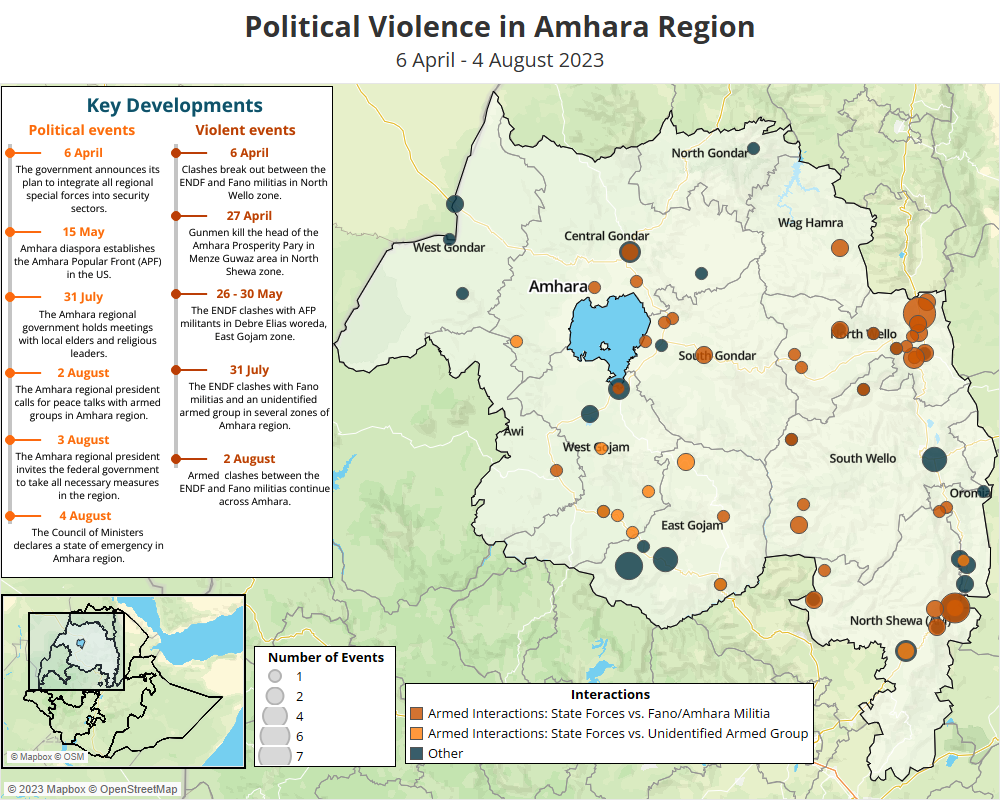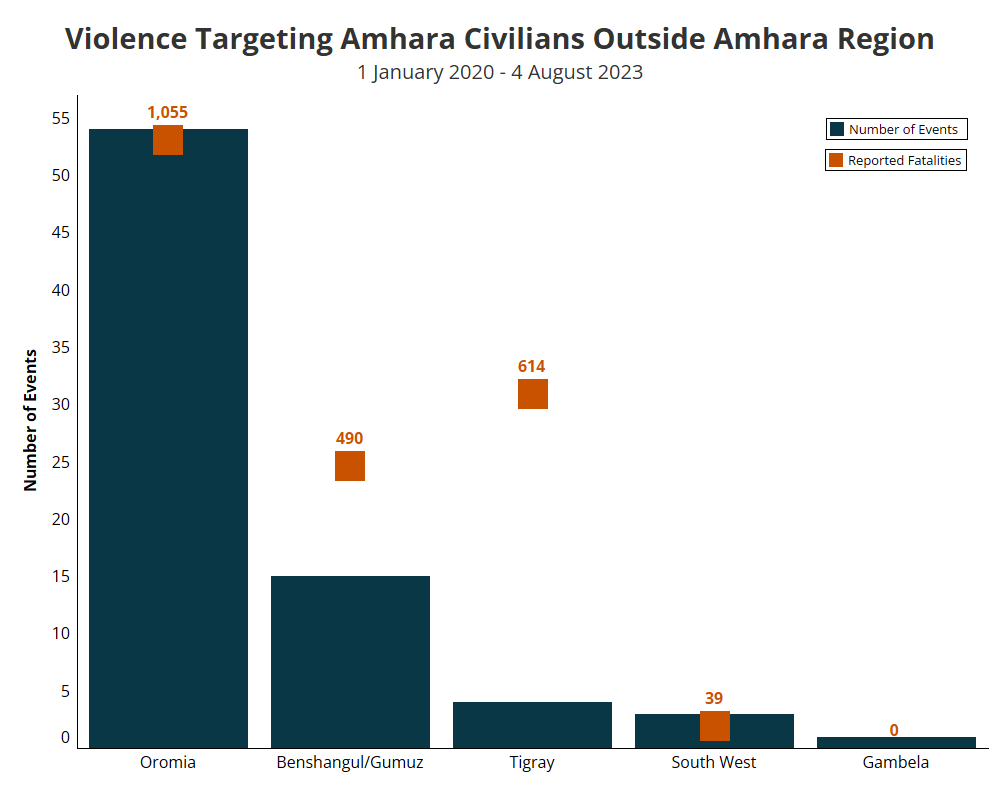By the Numbers: Ethiopia, 29 July 2022-4 August 2023
- Total number of political violence events: 1,073
- Total number of reported fatalities from political violence: 4,027
- Total number of reported fatalities from civilian targeting: 1,918
By the Numbers: Ethiopia, 29 July-4 August 20231Some events from this coverage period might be included in the data in subsequent weeks due to reporting delays.
- Total number of political violence events: 39
- Total number of reported fatalities from political violence: 46
- Total number of reported fatalities from civilian targeting: 9
Ethiopia data are available through a curated EPO data file as well as the main ACLED export tool.

Situation Summary
Political violence reached new levels of intensity in Amhara region last week since the peace agreement between the federal government and the Tigray People’s Liberation Front (TPLF) ended the northern conflict.2Addis Maleda, ‘The Amhara government requested the federal government to implement the necessary legal framework to control the lack of security in the Amhara region,’ 3 August 2023 Following the government’s announcement to integrate all regional special forces into various security forces at the beginning of April, Amhara region has become one of the most unstable regions in the country, as ACLED records frequent armed clashes between government forces and Fano militias (see map below), as well as demonstration events. The unrest further escalated when the federal government deployed the Ethiopian National Defense Force (ENDF) to take action against “extremist forces” after an unidentified armed group killed the head of the Amhara faction of the ruling Prosperity Party on 27 April.3Fana Broadcasting Corporate, ‘The Security and Safety Joint Task Force announced that it is taking decisive action against the extremist forces that are trying to take control of regional power by destroying the constitutional system in Amhara region,’ 28 April 2023

ACLED records 28 armed clash events between the ENDF and Fano militias last week, with most clashes in North Wello and West Gojam zones. Fano militias managed to take control of some towns and released prisoners.4FBC, ‘Details provided by the Chairman of the state of emergency proclamation, Mr. Temeseng Tiruneh, regarding the further work of the Proclamation,’ 6 August 2023 There were also several violent demonstrations, wherein demonstrators closed roads in Debre Markos, Dembecha, Bure, and Amanuel towns to halt ENDF forces’ movement in the region. According to one local official, the armed clashes in East and West Gojam zones erupted when the ENDF began to mobilize to east Amhara.5Ethiopian Media Services, ‘EMS Eletawi Wed 02 August 2023,’ 2 August 2023
Due to the unrest, the Amhara regional government asked the federal government to take all necessary measures as the insecurity in the region went beyond the control of the regional security forces.6Addis Maleda, ‘The Amhara government requested the federal government to implement the necessary legal framework to control the lack of security in the Amhara region,’ 3 August 2023 As a result, on 4 August, the Council of Ministers declared a six-month state of emergency in Amhara region.7Office of the Prime Minister-Ethiopia, ‘Decisions of the 23rd regular meeting of the Council of Ministers,’ 4 August 2023; FDRE Government Communication Service, ‘State of Emergency Proclamation 6/2015,’ 4 August 2023; Addis Maleda, ‘The Amhara government requested the federal government to implement the necessary legal framework to control the lack of security in the Amhara region,’ 3 August 2023 The state of emergency proclamation consists of various civil and political rights restrictions, like restrictions on holding demonstrations and arresting people without a court order.8FDRE Government Communication Service, ‘State of Emergency Proclamation 6/2015,’ 4 August 2023; Ethiopian Broadcasting Corporation, ‘Details on the state of emergency proclamation declared by the Council of Ministers EBC | Etv | Ethiopia | News | daily news,’ 4 August 2023 The general attorney indicated that if necessary, the state of emergency could also be implemented in other parts of the country.9Ethiopian Broadcasting Corporation, ‘Details on the state of emergency proclamation declared by the Council of Ministers EBC | Etv | Ethiopia | News | daily news,’ 4 August 2023
Despite the declared state of emergency, armed clashes between Fano militias and the ENDF have continued in Amhara region this week.10ACLED data updates and EPO weekly reports will be paused during the last three weeks of August 2023. Data covering the period of 5 August to 1 September will be released on 4 September, after which regular updates will resume. A report covering this period will be published on 6 September. An unspecified number of high-profile people – including a member of the Amhara National Movement, House of Representatives member Christain Tadele, and a member of the Addis Ababa City Council, Dr. Kassa Teshager – have been arrested in connection with the ongoing conflict in Amhara region.11BBC Amharic, ‘Mr. Christian Tadele’s family stated that he was arrested by security forces,’ 5 August 2023 On 5 August, the head of the Federal Democratic Republic of Ethiopia (FDRE) Government Communication Service stated that arrests of people accused of having links with the situation in Amhara region began after the declaration of a state of emergency.12FDRE Government Communication Service, ‘The Minister of Government Communication Service stated that following the emergency proclamation issued by the Council of Ministers yesterday, the General Command Post of the Emergency Proclamation has been established and began its working,’ 5 August 2023
The Root Causes of the Conflict
Amhara region is the second most populated region of Ethiopia, with more than 30 million people. Amhara’s population and elected representatives have been strong supporters of Prime Minister Abiy Ahmed’s government since 2018, and they formed a crucial component of the national defense force during the war with TPLF forces – also known as the Tigray Defense Forces – from late 2020 through 2022. During that time, the Fano and other Amhara ethnic militias, fought alongside the ENDF against TPLF forces to defend their region and took control of contested areas, including areas within Western Tigray zone.
During and after the northern Ethiopia conflict, tensions grew between Amhara and federal forces around two central issues. First, political deadlocks on the status of Welkait, Humera, Tselemt, and Raya areas, which are officially under Tigray region but contain ethnic Amhara residents who wish to be governed by Amhara region (for details on recent protests in these areas, see EPO Weekly: 3-9 June 2023 and EPO Weekly: 17-23 June 2023). The government indicated its interest in holding a referendum in these areas to decide on this issue.13Ethiopia Insider, 6 July 2023 However, Amharas oppose holding a referendum and argue that since the TPLF-led government put these areas under Tigray region without any consultation with the local people in the 1990s, they want the government to make a political decision for these areas to be administered by Amhara region.14BBC Amharic, ‘What does Colonel Demeke Zewdu has to say about Welkait’s future and the charges against him?’ 19 june 2023; Getahun Asenake, ‘The representatives of Telemt walked out of the meeting as a proposal was made to hold a referendum on Raya and Telemt,’ Addis Maleda, 3 August 2023
The second issue is the overall state of security for the Amhara people. Government forces did not consistently defend them against the TPLF forces’ advancement in Amhara region during the northern Ethiopia conflict in 2021 and 2022 as its forces withdrew from towns and cities in Amhara and Afar regions where a significant part of the war occurred. Amhara civilians faced abuses by TPLF forces during the war, and Amhara settlers continued to be the victims of intermittent pogroms in Oromia and Benshangul/Gumuz regions (see graph below). The recent decision to eliminate regional special forces was regarded in Amhara as increasing the risk that the Amhara people will continue to be defenseless against the aggression of forces from other regions (for more on anti-government sentiments, see EPO Monthly: April 2021; and for more on anti-government demonstrations after civilian targeting events in Oromia region, see EPO Monthly: June 2022). Fano and Amharas accuse the government of engaging with the TPLF and the Oromo Liberation Front-Shane in peace talks in a way that removes accountability for the wrongs inflicted on the Amhara people – leaving Amhara region defenseless after disarming the special forces.

Who is involved in the current armed clashes in Amhara region and why?
At the moment, government forces, mainly the ENDF, are clashing with Fano and Amhara ethnic militias. Fano militias demand that federal ENDF troops withdraw from the region. They also accuse the regional and federal governments of being dominated by ethnic Oromos. Moreover, they demand that Welkait, Tselemt, Humera, and Raya areas be officially recognized as part of Amhara region.
What has changed and why is it important?
Previously, political discontent was generally expressed through demonstrations (for more, see EPO Monthly: June 2022 and EPO Weekly: 17-23 April 2021). However, since April 2023, a high number of armed clashes between Fano militias and government forces have been recorded, with most of these clashes occurring in North Wello and Noth Shewa zones (for more, see EPO Monthly: April 2023). So far, no armed clashes have been recorded between the two actors in Oromia special zone, and only one armed clash event was recorded in Awi zone on 10 June, which occurred when Fano militias from West Gojam zone tried to abduct local officials in the zone. Moreover, a high number of incidents of violence against local officials, including security forces, have been recorded in the region. This has forced some local officials to flee their homes. There is also a report indicating the regional police and kebele militias might have aligned with the Fano militias’ cause.15ESM, ‘EMS Mereja Mon 31 Jul 2023,’ 31 July 2023
Recent developments in Amhara region are a significant threat to security in Ethiopia as the region’s support is a cornerstone of the Abiy government, with Amhara region often regarded as the sole stable regional partner for the federal government. Losing support from a stable government in Amhara region will not bode well for the Abiy government because other strong regional partners, such as Oromia region, are consistently unstable. The violent developments in Amhara suggest that the federal government has asked the regional partners and Amhara communities to sacrifice too much without an exchange of authority or contested territory. It is a further indication that the peace agreement with the TPLF did not include concessions to a silent third main player (Amhara region) and that solving this very significant problem will involve some territorial concessions to Amhara region from the contested areas. This is a very dangerous impasse, and the federal government is unlikely to emerge unscathed. Instead, it will likely need to balance between trading off current Amhara instability and support for the federal government with future Tigray instability and no expectation of support from Amhara region to the federal government.
Further Reading:
- EPO Weekly: 1-7 July 2023 – assassinations of local security officials continued in Amhara region
- EPO Weekly: 17-23 June 2023 – demonstrations by ethnic Amharas in contested territories in Tigray region
- EPO Weekly: 10-16 June 2023 – political violence and unrest related to the government operation against “extremist” forces in Amhara
- EPO Weekly: 3-9 June 2023 – protests by ethnic Amhara residents of the contested Western Tigray zone, Tigray
- EPO April 2023 Monthly: Volatility in Amhara Region While the Rest of the Country Stabilizes – this report examines the root and proximate causes of conflict in Amhara region, the formation of regional special forces and Fano militias, Amhara nationalists, and potential flashpoints of violence
- EPO June 2023 Monthly: Political Violence Declines in Amhara Region Following Government Crackdown – this report looks at the temporary decline in political violence in Amhara region in June despite persistent high tensions, concluding that the presence of the ENDF and the government crackdown will not put a permanent end to unrest in the region, and that clashes are likely to resume






